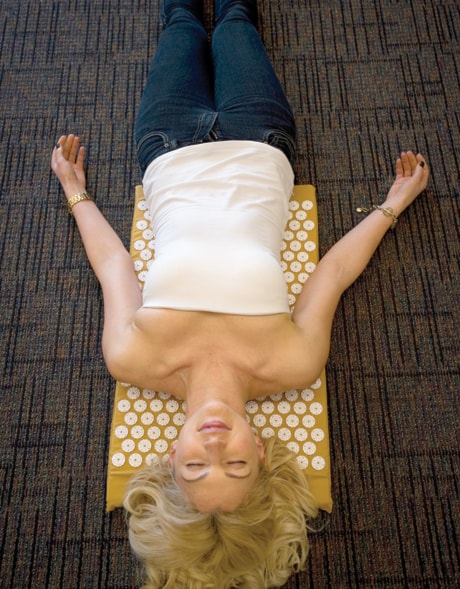Ow. Ow. Ow. Ow.
Shirt off, I ease myself down onto a cotton foam mat with hundreds of quarter-inch plastic spikes attached.
Ow. Ow. Ow.
Maybe, like entering a cold pool, it’s better to take the plunge and just flop onto this modern-day, purportedly therapeutic, version of the ancient Hindu bed of nails. But I generally prefer my pain to cascade over me gradually, not in a single jolt.
So down go my sacrum and lumbar regions. Ow. Ow. Here comes the thoracic area. Ow. Finally, the cervical spine, up to my scalp line, gets impaled as well.
I feel as if I landed on a porcupine. No, less intense. More like I’m being tenderized like a steak by a crazed chef.
But after a minute on the mat, just when I’m about ready to tell Olena Sholomytska, a personal trainer and the manufacturer of the spike mat, to show me some mercy and hoist me up, something strange happens: The pain morphs into a feeling not entirely unpleasant, a mix between a tingling sensation and the burn a runner might feel from a 5K finishing kick.
Ahhhh.
Is it endorphins or adrenaline kicking in, or have I turned mildly delusional?
After finishing my short sentence on the spikes, I can better understand why 600,000 fitness-loving Swedes might want to shell out the equivalent of $100 for this implement of restorative torture.
It’s not Sealy Posturepedic comfy by any means. But my back felt inexplicably supple and loose, two adjectives that are elusive as I lurch closer to age 50. Of course, these thoughts came to me after I peeled myself off the mat.
The experience itself reminded me of the old joke: Man One: “Why do you hit yourself over the head with a hammer?” Man Two: “Because it feels so good when I stop.”
Even hours after my six-minute demonstration — “You really need at least 20 minutes for the full effect,” Sholomytska insists — my crimson back looked like a recently aerated lawn.
The marks eventually faded. And, incongruously, my back felt better later in the day.
Placebo effect? Perhaps.
After all, no scientific studies have been undertaken to rate the efficacy of bed-of-nails therapy in treating injury, illness, insomnia and a bevy of other maladies. In Stockholm, where 3,000 adherents recently set a Guinness world record for shirtless group supine “spike-lying,” cynics have scoffed.
A doctor was recently quoted in the Swedish newspaper Svenska Dagbladet as saying there’s “nothing that even approaches a scientific proof for the effects.”
Sholomytska, 34, acknowledges the lack of research. But the native of Ukraine who recently resettled in Elk Grove, Calif., where her parents reside, happened to be living in Sweden when the craze began among yoga practitioners. She adds a postscript to the Swedish doctor’s negative pronouncement.
“They asked her on TV whether she’d recommend one,” Sholomytska adds, laughing, “and she said, ‘I use one.’ “
Point taken. Lots of points, actually.
Acupuncture was once the subject of similar skepticism, she says. With time and results, it eventually went mainstream and now is covered by many insurance plans.
And Sholomytska, who lived off and on in Sweden over the past decade, is betting that sales of spike mats will, well, spike in the west as well.
Her nascent company, StyleWellness (www.stylewellness.com), is believed to be the only U.S. manufacturer and distributor of spike mats. After a New York Times story out of Stockholm featured the fad, she says, she received hundreds of online orders from the East Coast for the organic-cotton mat. (Cost: $69.95.)
One customer is New York photographer-artist Steven Day, who lugs a lot of equipment around and is prone to shoulder and neck pain. He’s a surfer, too, and gets stiffness from that sport.
“What I do is roll up the mat a little and put it under my neck,” he says. “After a while, it kind of releases the muscles in the neck.”
Day admits wearing a thin T-shirt on the spikes. Bareback is too uncomfortable.
Sholomytska doesn’t consider herself an alternative healer. Instead, she had exhausted every other possibility to relieve insomnia, which left her exhausted.
“After a year of trying therapy, I went on sleeping pills for it,” she says. “But I didn’t like it. I felt dizzy all the time. My friend who’d been in a car accident and had (whiplash) was using (a spike mat) and told me it might help with my insomnia. When you’re desperate, you’re willing to walk through fire for relief.”
Sholomytska admits having initial trepidation, but she quickly overcame her anxiety.
“This is more intense than acupuncture,” she says. “I didn’t really feel the needles in acupuncture. Here, you feel the spikes. ... But I don’t want people to get scared, because you do get the marks. It goes away, so don’t get stressed.”
Stress is one condition alleviated by spike mats, enthusiasts claim. Other benefits, according to Sholomytska’s Web site: a strengthened immune system, increased uptake of oxygen, decreased inflammation, greater alertness and lower blood pressure.
Her insomnia long cured, Sholomytska says she spends 20 to 40 minutes a day on the spikes for relaxation.
“You start breathing more evenly, because if you’re lying on something sharp, you have to breathe evenly,” she says. “Massage therapists in Sweden have people come 20 minutes before the session to lie on it to get the muscles ready. And I know someone who uses it after work, sets an alarm clock for 30 minutes and lies on it to take a nap.”
Me? I hardly felt like napping. In fact, I was counting down every second of my six-minute session, wondering which is the better idea to come out of Sweden — Ikea or the spike mat?
Sam McManis is a writer for the Sacramento Bee.
